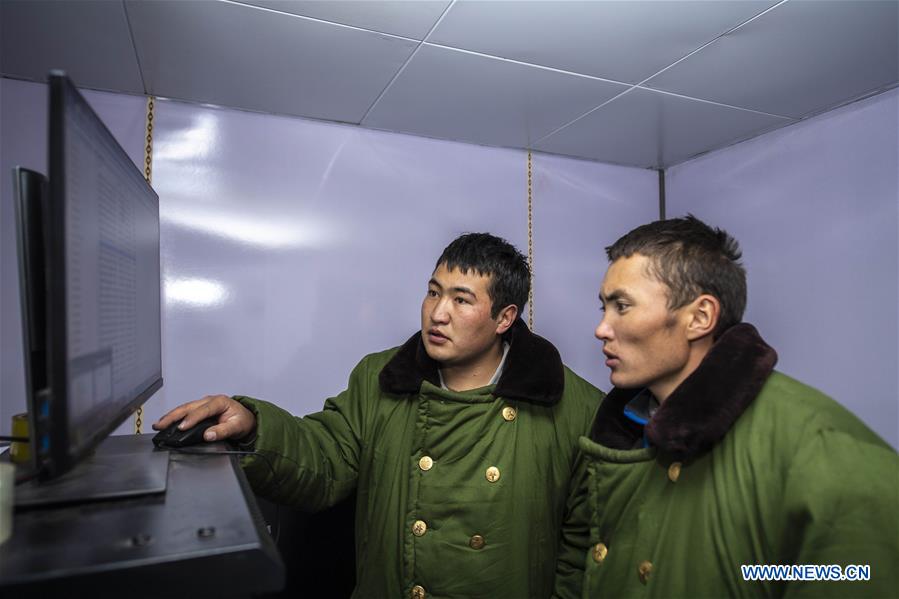
Astronomical assistant researchers Akli Tulti (R) and Nurlan Kanpel check data at the Muztagata observatory in northwest China's Xinjiang Uygur Autonomous Region, June 15, 2020. Located in western Xinjiang, Muztagata observatory, affiliated to Xinjiang Astronomical Observatory (XAO) of Chinese Academy of Sciences, sits at an altitude of 4,526 meters. It boasts unique geographic location and superb observing conditions for astronomical observation. Given the unfavorable living conditions, staff here work in shifts and live in Subasi Village at a relatively low altitude. When journalists of Xinhua arrived there, it is Feng Guojie, an astronomical researcher of the observatory, who is in the night shift. Along with two assistants, they drove for 40 minutes on winding road in mountainous areas to reach the observatory from their living place. At around 10 p.m. (Beijing time), Feng and his assistants were ready to work. They needed to check facilities and devices for late-night observation, and make fire in a stove because the temperature drops to zero degree Celsius even in summer as they stayed up late to work. Since the observatory was put into use in January of 2017, a lot of researchers who engaged in astronomical study have spent their nights here to observe the starry sky, record data and perform analysis. Their persistence and devotion to astronomy has laid a solid foundation for the scientific development. (Xinhua/Hu Huhu)

Feng Guojie, an astronomical researcher, measures his blood oxygen saturation in Subasi Village of Akto County, northwest China's Xinjiang Uygur Autonomous Region, June 15, 2020. Located in western Xinjiang, Muztagata observatory, affiliated to Xinjiang Astronomical Observatory (XAO) of Chinese Academy of Sciences, sits at an altitude of 4,526 meters. It boasts unique geographic location and superb observing conditions for astronomical observation. Given the unfavorable living conditions, staff here work in shifts and live in Subasi Village at a relatively low altitude. When journalists of Xinhua arrived there, it is Feng Guojie, an astronomical researcher of the observatory, who is in the night shift. Along with two assistants, they drove for 40 minutes on winding road in mountainous areas to reach the observatory from their living place. At around 10 p.m. (Beijing time), Feng and his assistants were ready to work. They needed to check facilities and devices for late-night observation, and make fire in a stove because the temperature drops to zero degree Celsius even in summer as they stayed up late to work. Since the observatory was put into use in January of 2017, a lot of researchers who engaged in astronomical study have spent their nights here to observe the starry sky, record data and perform analysis. Their persistence and devotion to astronomy has laid a solid foundation for the scientific development. (Xinhua/Hu Huhu)
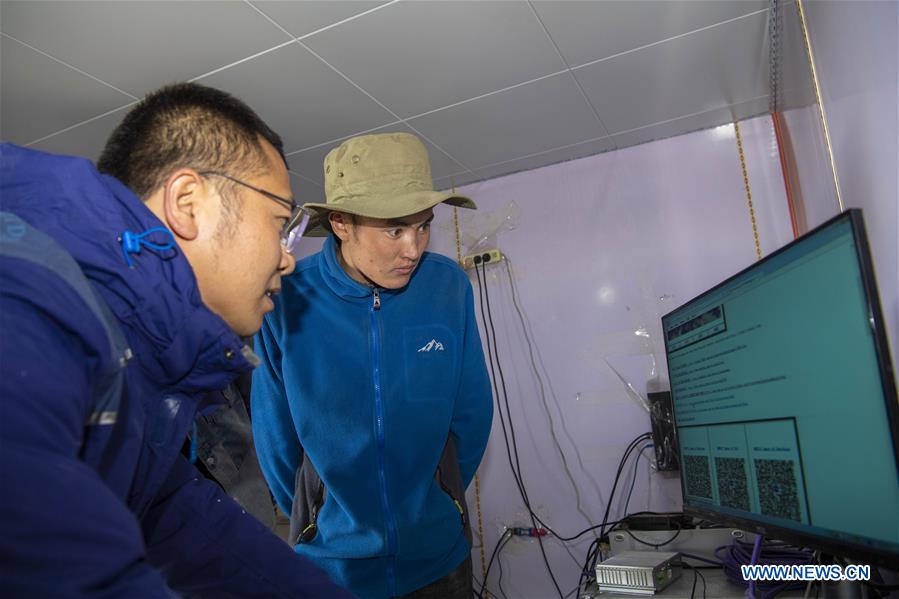
Feng Guojie (L), an astronomical researcher, explains late-night observation to his assistant Akli Tulti at the Muztagata observatory in northwest China's Xinjiang Uygur Autonomous Region, June 15, 2020. Located in western Xinjiang, Muztagata observatory, affiliated to Xinjiang Astronomical Observatory (XAO) of Chinese Academy of Sciences, sits at an altitude of 4,526 meters. It boasts unique geographic location and superb observing conditions for astronomical observation. Given the unfavorable living conditions, staff here work in shifts and live in Subasi Village at a relatively low altitude. When journalists of Xinhua arrived there, it is Feng Guojie, an astronomical researcher of the observatory, who is in the night shift. Along with two assistants, they drove for 40 minutes on winding road in mountainous areas to reach the observatory from their living place. At around 10 p.m. (Beijing time), Feng and his assistants were ready to work. They needed to check facilities and devices for late-night observation, and make fire in a stove because the temperature drops to zero degree Celsius even in summer as they stayed up late to work. Since the observatory was put into use in January of 2017, a lot of researchers who engaged in astronomical study have spent their nights here to observe the starry sky, record data and perform analysis. Their persistence and devotion to astronomy has laid a solid foundation for the scientific development. (Xinhua/Hu Huhu)
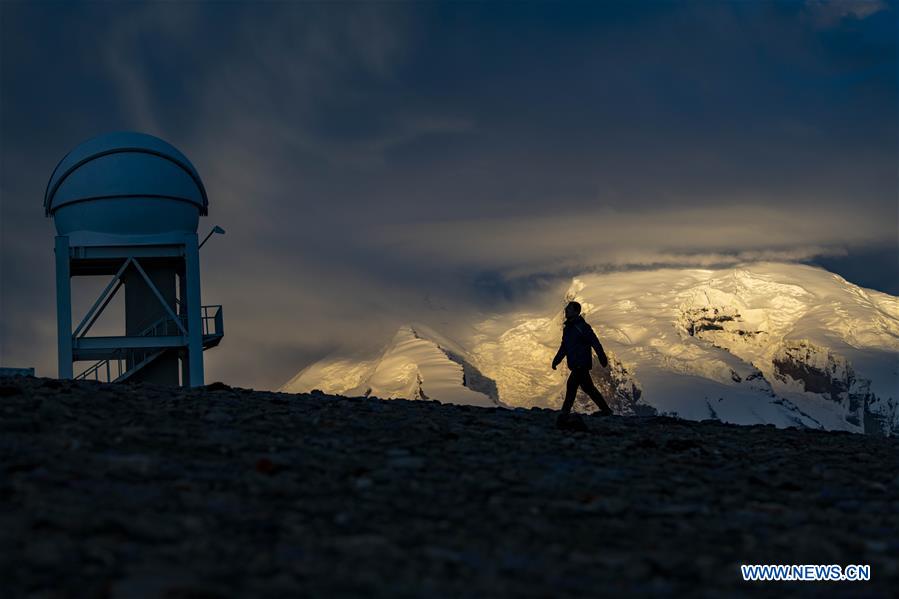
Feng Guojie, an astronomical researcher, patrols at the Muztagata observatory in northwest China's Xinjiang Uygur Autonomous Region, June 15, 2020. Located in western Xinjiang, Muztagata observatory, affiliated to Xinjiang Astronomical Observatory (XAO) of Chinese Academy of Sciences, sits at an altitude of 4,526 meters. It boasts unique geographic location and superb observing conditions for astronomical observation. Given the unfavorable living conditions, staff here work in shifts and live in Subasi Village at a relatively low altitude. When journalists of Xinhua arrived there, it is Feng Guojie, an astronomical researcher of the observatory, who is in the night shift. Along with two assistants, they drove for 40 minutes on winding road in mountainous areas to reach the observatory from their living place. At around 10 p.m. (Beijing time), Feng and his assistants were ready to work. They needed to check facilities and devices for late-night observation, and make fire in a stove because the temperature drops to zero degree Celsius even in summer as they stayed up late to work. Since the observatory was put into use in January of 2017, a lot of researchers who engaged in astronomical study have spent their nights here to observe the starry sky, record data and perform analysis. Their persistence and devotion to astronomy has laid a solid foundation for the scientific development. (Xinhua/Hu Huhu)

Astronomical researcher Feng Guojie (C) and his assistants Akli Tulti (R) and Nurlan Kanpel pose for a photo at the Muztagata observatory in northwest China's Xinjiang Uygur Autonomous Region, June 15, 2020. Located in western Xinjiang, Muztagata observatory, affiliated to Xinjiang Astronomical Observatory (XAO) of Chinese Academy of Sciences, sits at an altitude of 4,526 meters. It boasts unique geographic location and superb observing conditions for astronomical observation. Given the unfavorable living conditions, staff here work in shifts and live in Subasi Village at a relatively low altitude. When journalists of Xinhua arrived there, it is Feng Guojie, an astronomical researcher of the observatory, who is in the night shift. Along with two assistants, they drove for 40 minutes on winding road in mountainous areas to reach the observatory from their living place. At around 10 p.m. (Beijing time), Feng and his assistants were ready to work. They needed to check facilities and devices for late-night observation, and make fire in a stove because the temperature drops to zero degree Celsius even in summer as they stayed up late to work. Since the observatory was put into use in January of 2017, a lot of researchers who engaged in astronomical study have spent their nights here to observe the starry sky, record data and perform analysis. Their persistence and devotion to astronomy has laid a solid foundation for the scientific development. (Xinhua/Hu Huhu)

Akli Tulti, an astronomical assistant researcher, prepares for observation at the Muztagata observatory in northwest China's Xinjiang Uygur Autonomous Region, June 15, 2020. Located in western Xinjiang, Muztagata observatory, affiliated to Xinjiang Astronomical Observatory (XAO) of Chinese Academy of Sciences, sits at an altitude of 4,526 meters. It boasts unique geographic location and superb observing conditions for astronomical observation. Given the unfavorable living conditions, staff here work in shifts and live in Subasi Village at a relatively low altitude. When journalists of Xinhua arrived there, it is Feng Guojie, an astronomical researcher of the observatory, who is in the night shift. Along with two assistants, they drove for 40 minutes on winding road in mountainous areas to reach the observatory from their living place. At around 10 p.m. (Beijing time), Feng and his assistants were ready to work. They needed to check facilities and devices for late-night observation, and make fire in a stove because the temperature drops to zero degree Celsius even in summer as they stayed up late to work. Since the observatory was put into use in January of 2017, a lot of researchers who engaged in astronomical study have spent their nights here to observe the starry sky, record data and perform analysis. Their persistence and devotion to astronomy has laid a solid foundation for the scientific development. (Xinhua/Hu Huhu)

Feng Guojie, an astronomical researcher, works on a computer at the Muztagata observatory in northwest China's Xinjiang Uygur Autonomous Region, June 15, 2020. Located in western Xinjiang, Muztagata observatory, affiliated to Xinjiang Astronomical Observatory (XAO) of Chinese Academy of Sciences, sits at an altitude of 4,526 meters. It boasts unique geographic location and superb observing conditions for astronomical observation. Given the unfavorable living conditions, staff here work in shifts and live in Subasi Village at a relatively low altitude. When journalists of Xinhua arrived there, it is Feng Guojie, an astronomical researcher of the observatory, who is in the night shift. Along with two assistants, they drove for 40 minutes on winding road in mountainous areas to reach the observatory from their living place. At around 10 p.m. (Beijing time), Feng and his assistants were ready to work. They needed to check facilities and devices for late-night observation, and make fire in a stove because the temperature drops to zero degree Celsius even in summer as they stayed up late to work. Since the observatory was put into use in January of 2017, a lot of researchers who engaged in astronomical study have spent their nights here to observe the starry sky, record data and perform analysis. Their persistence and devotion to astronomy has laid a solid foundation for the scientific development. (Xinhua/Hu Huhu)
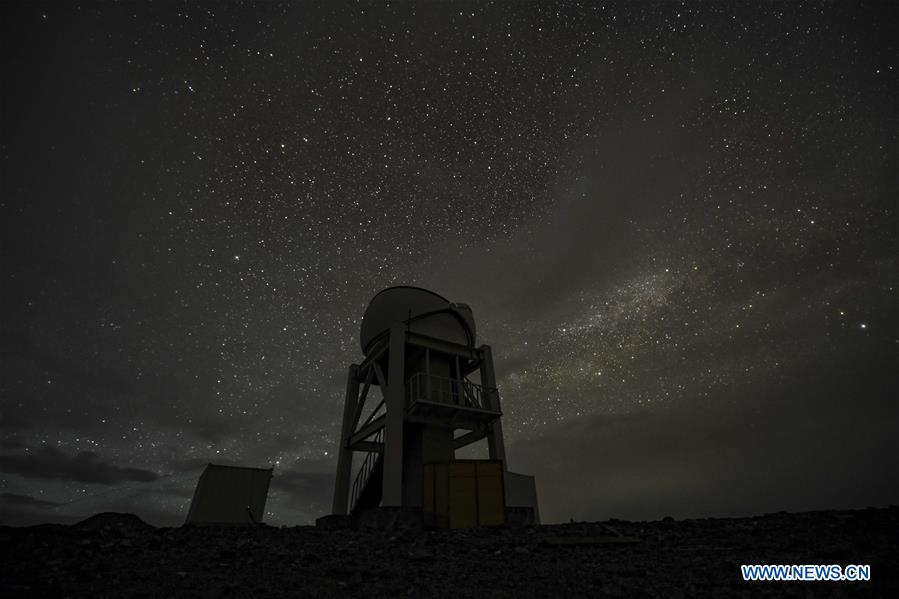
Photo taken with a long-time expoture shows a view of the Muztagata observatory, northwest China's Xinjiang Uygur Autonomous Region, June 16, 2020. Located in western Xinjiang, Muztagata observatory, affiliated to Xinjiang Astronomical Observatory (XAO) of Chinese Academy of Sciences, sits at an altitude of 4,526 meters. It boasts unique geographic location and superb observing conditions for astronomical observation. Given the unfavorable living conditions, staff here work in shifts and live in Subasi Village at a relatively low altitude. When journalists of Xinhua arrived there, it is Feng Guojie, an astronomical researcher of the observatory, who is in the night shift. Along with two assistants, they drove for 40 minutes on winding road in mountainous areas to reach the observatory from their living place. At around 10 p.m. (Beijing time), Feng and his assistants were ready to work. They needed to check facilities and devices for late-night observation, and make fire in a stove because the temperature drops to zero degree Celsius even in summer as they stayed up late to work. Since the observatory was put into use in January of 2017, a lot of researchers who engaged in astronomical study have spent their nights here to observe the starry sky, record data and perform analysis. Their persistence and devotion to astronomy has laid a solid foundation for the scientific development. (Xinhua/Hu Huhu)
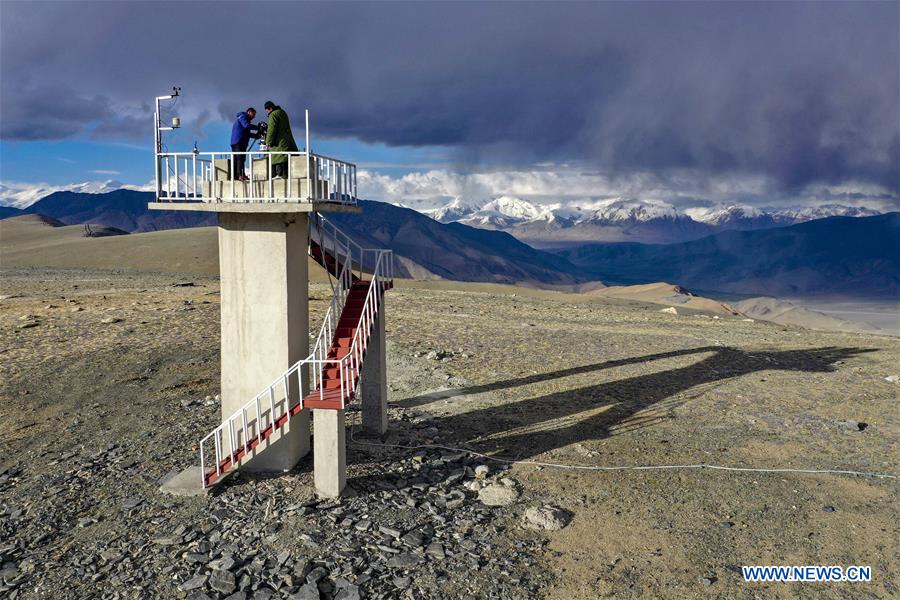
Aerial photo taken on June 15, 2020 shows Feng Guojie, an astronomical researcher, and an assistant working at the Muztagata observatory in northwest China's Xinjiang Uygur Autonomous Region. Located in western Xinjiang, Muztagata observatory, affiliated to Xinjiang Astronomical Observatory (XAO) of Chinese Academy of Sciences, sits at an altitude of 4,526 meters. It boasts unique geographic location and superb observing conditions for astronomical observation. Given the unfavorable living conditions, staff here work in shifts and live in Subasi Village at a relatively low altitude. When journalists of Xinhua arrived there, it is Feng Guojie, an astronomical researcher of the observatory, who is in the night shift. Along with two assistants, they drove for 40 minutes on winding road in mountainous areas to reach the observatory from their living place. At around 10 p.m. (Beijing time), Feng and his assistants were ready to work. They needed to check facilities and devices for late-night observation, and make fire in a stove because the temperature drops to zero degree Celsius even in summer as they stayed up late to work. Since the observatory was put into use in January of 2017, a lot of researchers who engaged in astronomical study have spent their nights here to observe the starry sky, record data and perform analysis. Their persistence and devotion to astronomy has laid a solid foundation for the scientific development. (Xinhua/Hu Huhu)

Feng Guojie, an astronomical researcher, cooks at his living area in Subasi Village of Akto County, in northwest China's Xinjiang Uygur Autonomous Region, June 16, 2020. Located in western Xinjiang, Muztagata observatory, affiliated to Xinjiang Astronomical Observatory (XAO) of Chinese Academy of Sciences, sits at an altitude of 4,526 meters. It boasts unique geographic location and superb observing conditions for astronomical observation. Given the unfavorable living conditions, staff here work in shifts and live in Subasi Village at a relatively low altitude. When journalists of Xinhua arrived there, it is Feng Guojie, an astronomical researcher of the observatory, who is in the night shift. Along with two assistants, they drove for 40 minutes on winding road in mountainous areas to reach the observatory from their living place. At around 10 p.m. (Beijing time), Feng and his assistants were ready to work. They needed to check facilities and devices for late-night observation, and make fire in a stove because the temperature drops to zero degree Celsius even in summer as they stayed up late to work. Since the observatory was put into use in January of 2017, a lot of researchers who engaged in astronomical study have spent their nights here to observe the starry sky, record data and perform analysis. Their persistence and devotion to astronomy has laid a solid foundation for the scientific development. (Xinhua/Hu Huhu)

Astronomical assistant researchers Akli Tulti (L) and Nurlan Kanpel work at the Muztagata observatory in northwest China's Xinjiang Uygur Autonomous Region, June 15, 2020. Located in western Xinjiang, Muztagata observatory, affiliated to Xinjiang Astronomical Observatory (XAO) of Chinese Academy of Sciences, sits at an altitude of 4,526 meters. It boasts unique geographic location and superb observing conditions for astronomical observation. Given the unfavorable living conditions, staff here work in shifts and live in Subasi Village at a relatively low altitude. When journalists of Xinhua arrived there, it is Feng Guojie, an astronomical researcher of the observatory, who is in the night shift. Along with two assistants, they drove for 40 minutes on winding road in mountainous areas to reach the observatory from their living place. At around 10 p.m. (Beijing time), Feng and his assistants were ready to work. They needed to check facilities and devices for late-night observation, and make fire in a stove because the temperature drops to zero degree Celsius even in summer as they stayed up late to work. Since the observatory was put into use in January of 2017, a lot of researchers who engaged in astronomical study have spent their nights here to observe the starry sky, record data and perform analysis. Their persistence and devotion to astronomy has laid a solid foundation for the scientific development. (Xinhua/Hu Huhu)
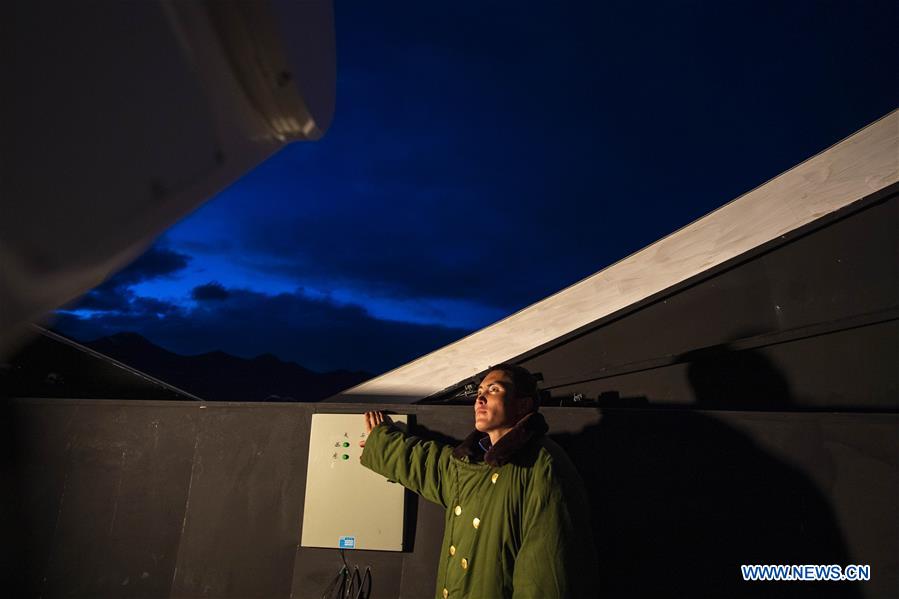
Akli Tulti, an astronomical assistant researcher, prepares for observation at the Muztagata observatory in northwest China's Xinjiang Uygur Autonomous Region, June 15, 2020. Located in western Xinjiang, Muztagata observatory, affiliated to Xinjiang Astronomical Observatory (XAO) of Chinese Academy of Sciences, sits at an altitude of 4,526 meters. It boasts unique geographic location and superb observing conditions for astronomical observation. Given the unfavorable living conditions, staff here work in shifts and live in Subasi Village at a relatively low altitude. When journalists of Xinhua arrived there, it is Feng Guojie, an astronomical researcher of the observatory, who is in the night shift. Along with two assistants, they drove for 40 minutes on winding road in mountainous areas to reach the observatory from their living place. At around 10 p.m. (Beijing time), Feng and his assistants were ready to work. They needed to check facilities and devices for late-night observation, and make fire in a stove because the temperature drops to zero degree Celsius even in summer as they stayed up late to work. Since the observatory was put into use in January of 2017, a lot of researchers who engaged in astronomical study have spent their nights here to observe the starry sky, record data and perform analysis. Their persistence and devotion to astronomy has laid a solid foundation for the scientific development. (Xinhua/Hu Huhu)
